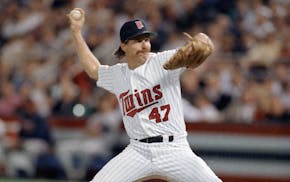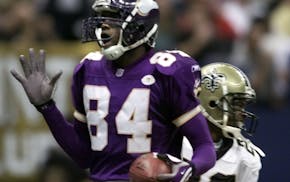Covering sports teams and going to sporting events has been part of my everyday life and career for eight decades, and it's hard to believe the way the sporting world has been impacted this week by a virus that has basically shut down every major sporting event in the country and in Minnesota.
Everyone in the leagues and in the offices of the Gophers, Timberwolves, Vikings, Twins, Wild and every other sports operation in this state knows there might be times when they have to make tough decisions about whether to play.
Still, sports are important not only to fans and players and teams, but also to the huge economy that supports these events.
There have been times in my career when sports have taken a back seat to much larger concerns in the country, but they have also been a key part of holding Minnesota and the country together during difficult times.
The first column I ever wrote for the paper was on Sept. 11, 1945, about a week after the end of World War II.
And while there may not be a comparison in terms of the war and this health scare, the fact is that during the war years sports proved to be a key factor in keeping people together and bringing the country back.
My first column in the paper started like this:
"Ticket Manager Marsh Ryman reports that the football ducat sale is the highest since the start of the war. Mail order for season tickets closed Saturday. The estimated sale is around 9,500. This is far from the 17,000 that were sold in 1937, but a lot better than any of the war years. Incidentally the University of Minnesota is protected even if it can't replace the Seahawk game. The season-ticket book clearly states more than one game must be postponed before a refund is necessary.
"However, this doesn't mean the boys aren't trying to get a game. They want one and are doing their best to line one up."
Everyone impacted
The rest of the column featured updates on players who had been impacted by the war.
The great Pat Harder, who played running back at Wisconsin and made the College Football Hall of Fame, was waiting on a discharge from the Marines after a knee operation. His teammate Elroy Hirsch, one of the best football players ever, was also in the Marine Corps.
I also had an item after talking with Bob Hanzlik, another Wisconsin football standout who had enrolled at the University of Minnesota following the war.
"Bob Hanzlik still is getting back letters that he wrote to his Wisconsin teammates, Dave Schreiner and Tom Baumann, who were killed at Okinawa," the column read. "Hanzlik wrote to Schreiner every week during the 18 months he was overseas. … Incidentally, Bob thinks Wisconsin got an awfully tough break when they lost backfield coach Howie O'Dell in 1942. Hanzlik says the Badgers were crazy about O'Dell and he had plenty to do with developing the '42 club. O'Dell coached in the spring and then left in the fall to take a head coaching job at Yale."
Even then, in the most difficult of times for someone like Hanzlik, football was a way to not focus so much on the difficulties of the war.
Of course, the current situation around sports doesn't have the gravity of those days in the 1930s and '40s, but you can still feel how the loss of sports signals that the country is in a difficult position.
But it's also true that when games are played again, it will bring a lot of comfort to teams and fans.
Pro-Minneapolis
As I approach my 100th birthday, it's easy to say that one of the biggest accomplishments in my life is playing a small part in helping to bring major league sports to Minnesota.
The fact is I have watched this town go from being one with no professional sports teams to one of only 13 cities in the country with an NFL, NBA, NHL and MLB franchise.
I was involved in the first pro sports franchise in the state when I helped bring the Minneapolis Lakers here in 1947, which turned out to be a big success as they won six championships, including five NBA titles.
A group of business leaders in the state had brought in National Basketball League teams Oshkosh and Sheboygan for an exhibition game in 1946, and it drew 5,500 to the Minneapolis Auditorium. I had read that the Detroit Gems pro basketball franchise was up for sale, so I approached a couple of Minneapolis businessmen — Morris Chalfin and Ben Berger — for the $15,000 it would take to buy the Gems.
I went to the airport with that check in my hand, and Minneapolis landed its first pro sports franchise.
That was the start of the Lakers.
Newspapers did PR
It might seem strange that a sportswriter was involved with operating a team, but in those days the sports editors allowed every staff member to do public relations for some kind of a sport, whether it be professional wrestling, basketball, boxing or anything like that.
You could never do that now at the Star Tribune or any other newspaper, nobody would even think of it. But in those days it was allowed and even encouraged.
Back then sportswriters didn't make a lot of money, so having a side PR job was allowed for years. No doubt there was conflict of interest in all of these moves. But the paper encouraged it, because they were so eager to make this a major league city and felt that I could be a help because of my contacts.
For 10 years I ran the club with the permission of Max Winter, the Lakers general manager who spent most of the basketball season in Hawaii. I made most of the personnel decisions and handled the draft and contract negotiations until Bob Short bought the team in 1957.
Unfortunately, after becoming the first pro sports dynasty, the Lakers ran into problems. They had some down seasons and couldn't find a building to play regular games in, and they wound up moving to Los Angeles, where they have been very successful.
Last month, Forbes Magazine ran a list of the top values for NBA franchises — the Lakers ranked No. 2 at $4.4 billion.
To think it all started in 1947 with $15,000.
I owe a lot of appreciation to some of the businessmen who showed me great thanks for these contributions with the building of a statue in downtown Minneapolis that stands between Target Center and Target Field.
Sid Hartman can be heard on WCCO AM-830 at 8:40 a.m. Monday and Friday, 2 p.m. Friday and 10 a.m. Sunday. • shartman@startribune.com

Sid Instant Replay from 1977: Vikings' Super Bowl loss to Raiders hurt the most

Read Sid's column from 1974, when Ara Parseghian left Notre Dame

Sid instant replay: No greater hero than Twins' Morris in World Series


